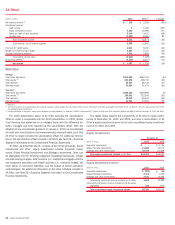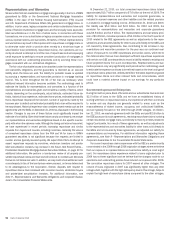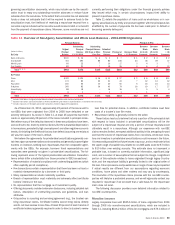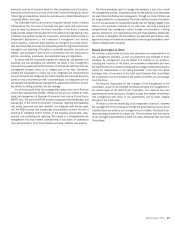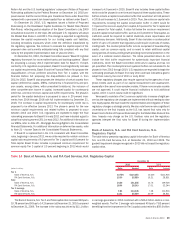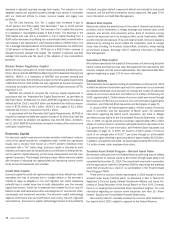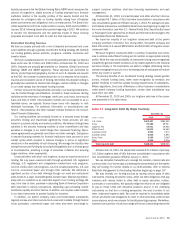Bank of America 2010 Annual Report Download - page 65
Download and view the complete annual report
Please find page 65 of the 2010 Bank of America annual report below. You can navigate through the pages in the report by either clicking on the pages listed below, or by using the keyword search tool below to find specific information within the annual report.on the consolidated liabilities, subject to certain exclusions and offsets, of U.K.
group companies and U.K. branches of foreign banking groups as of each year-
end balance sheet date. As currently proposed, the bank levy rate for 2011 and
future years will be 0.075 percent per annum for certain short-term liabilities
with a rate of 0.0375 percent per annum for longer maturity liabilities and
certain deposits. The legislation is expected to be enacted in the third quarter
of 2011. We currently estimate that the cost of the U.K. bank levy will be
approximately $125 million annually beginning in 2011.
Regulatory Guidance on Collateral Dependent Loans
On February 23, 2010, regulators issued clarifying guidance, effective in the
first quarter of 2010, on modified consumer real estate loans that specifies
criteria required to demonstrate a borrower’s capacity to repay the modified
loan. In connection with this guidance, we reviewed our modified consumer
real estate loans and determined that a portion of these loans did not meet
the criteria and, therefore, were deemed collateral dependent. The guidance
requires that a modified loan deemed to be collateral dependent be written
down to its estimated collateral value even if that loan is performing. The
application of this guidance resulted in $1.0 billion of net charge-offs in 2010,
of which $822 million were home equity, $207 million were residential
mortgage and $9 million were discontinued real estate.
Making Home Affordable Program
On March 4, 2009, the U.S. Treasury provided details related to the $75 billion
Making Home Affordable program (MHA) which is focused on reducing the
number of foreclosures and making it easier for customers to refinance loans.
The MHA consists of the Home Affordable Modification Program (HAMP) which
provides guidelines on first-lien loan modifications, and the Home Affordable
Refinance Program (HARP) which provides guidelines for loan refinancing.
As part of the MHA program, on April 28, 2009, the U.S. government
announced intentions to create the second-lien modification program (2MP)
that is designed to reduce the monthly payments on qualifying home equity
loans and lines of credit under certain conditions, including completion of a
HAMP modification on the first mortgage on the property. This program
provides incentives to lenders to modify all eligible loans that fall under
the guidelines of this program. Additional clarification on government guide-
lines for the program was announced early in 2010. On April 8, 2010, we
began early implementation of the 2MP with the mailing of trial modification
offers to eligible home equity customers. We will modify eligible second liens
under this initiative regardless of whether the MHA modified “first lien” is
serviced by the Corporation or another participating servicer.
On April 5, 2010, we implemented the Home Affordable Foreclosure
Alternatives (HAFA) program, which is another addition to the HAMP that
assists borrowers with non-retention options, such as short sale or dee-
d-in-lieu options, instead of foreclosure. The HAFA program provides incen-
tives to lenders to assist all eligible borrowers that fall under the guidelines of
this program. Our first goal is to work with the borrower to determine if a loan
modification or other homeownership retention solution is available before
pursuing non-retention options such as short sales. Short sales are an
important option for homeowners who are facing financial difficulty and do
not have a viable option to remain in the home. HAFA’s short sale guidelines
are designed to streamline and standardize the process and will be compat-
ible with Bank of America’s new cooperative short sale program.
During 2010, 285,000 loan modifications were completed with a total
unpaid principal balance of $65.7 billion, including 109,000 loans with a total
unpaid principal amount of $25.5 billion that were converted from trial-period to
permanent modifications under the MHA, which include HAMP first-lien mod-
ifications and 2MP second-lien modifications. In addition, on March 26, 2010,
the U.S. government announced new changes to the MHA program guidelines
that include principal forgiveness options to the HAMP for a sub-segment of
qualified HAMP borrowers. The details around eligibility, forgiveness arrange-
ments and the incentive structures are still being finalized. However, we
implemented a forgiveness program on a subset of HAMP eligible products
under the National Home Retention Program (NHRP) in 2010.
In addition to the programs described above, we have implemented
several programs designed to help our customers. For information on these
programs, refer to Credit Risk Management beginning on page 75. We will
continue to help our customers address financial challenges through these
government programs and our own home retention programs.
Stress Tests
The Corporation has established management routines to periodically con-
duct stress tests to evaluate potential impacts to the Corporation under
hypothetical economic scenarios. These stress tests will facilitate our con-
tingency planning and management of capital and liquidity. These processes
were also used to conduct the recent secondary stress testing imposed by the
Federal Reserve and were incorporated into the Capital Plan that was sub-
mitted as part of this request, which included a proposed modest increase in
our common dividend in the second half of 2011. The results of these stress
tests may influence bank regulatory supervisory requirements concerning the
Corporation and may impact the amount or timing of dividends or distributions
to the Corporation’s stockholders. For additional information, see Capital
Management beginning on page 67 and Liquidity Risk beginning on page 71.
Other Matters
The Corporation has established guidelines and policies for managing capital
across its subsidiaries. The guidance for the Corporation’s subsidiaries with
regulatory capital requirements, including branch operations of banking sub-
sidiaries, requires each entity to maintain satisfactory capital levels. This
includes setting internal capital targets for the U.S. bank subsidiaries to
exceed “well capitalized” levels.
The U.K. has adopted increased capital and liquidity requirements for local
financial institutions, including regulated U.K. subsidiaries of non-U.K. bank
holding companies and other financial institutions as well as branches of non-
U.K. banks located in the U.K. In addition, the U.K. has proposed the creation
and production of recovery and resolution plans (commonly referred to as
living wills) by such entities. We are currently monitoring the impact of these
initiatives.
Managing Risk
Overview
Risk is inherent in every activity that we undertake. Our business exposes us
to strategic, credit, market, liquidity, compliance, operational and reputational
risk. We must manage these risks to maximize our long-term results by
ensuring the integrity of our assets and the quality of our earnings.
Strategic risk is the risk that results from adverse business decisions,
ineffective or inappropriate business plans, or failure to respond to changes
in the competitive environment, business cycles, customer preferences,
product obsolescence, regulatory environment, business strategy execution,
and/or other inherent risks of the business including reputational risk. Credit
risk is the risk of loss arising from a borrower’s or counterparty’s inability to
meet its obligations. Market risk is the risk that values of assets and liabilities
or revenues will be adversely affected by changes in market conditions such
as interest rate movements. Liquidity risk is the inability to meet contractual
and contingent financial obligations, on- or off-balance sheet, as they come
due. Compliance risk is the risk that arises from the failure to adhere to laws,
rules, regulations, or internal policies and procedures. Operational risk is the
risk of loss resulting from inadequate or failed internal processes, people and
systems, or external events. Reputational risk is the potential that negative
Bank of America 2010 63



